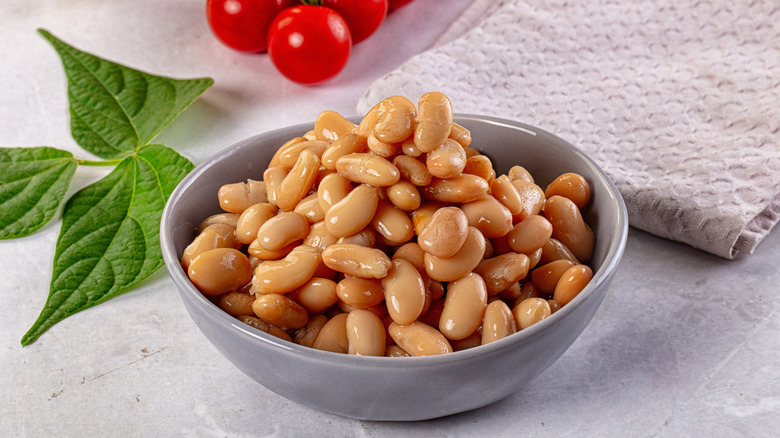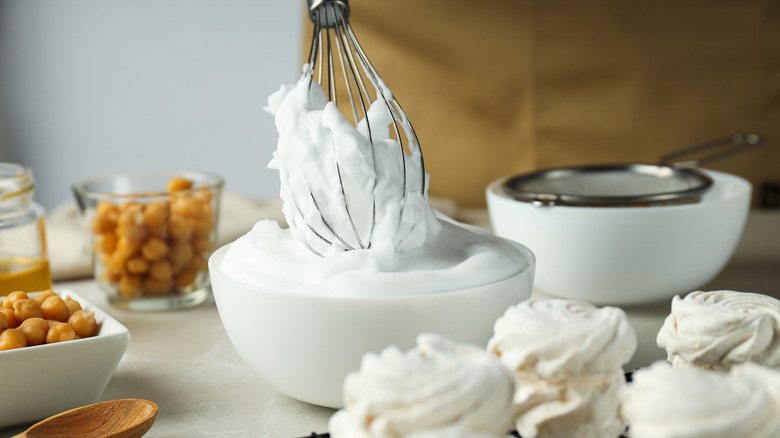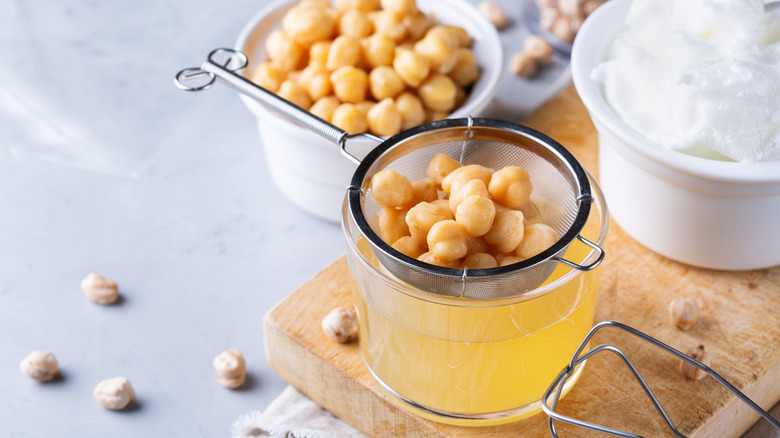Don't Toss That Liquid From Canned Beans: Use It As A Thickener
Canned beans are a versatile and budget-friendly pantry staple, with canned chickpeas serving as a base for homemade hummus, pinto beans having a variety of uses in Mexican cuisine, and canned black-eyes peas adding a hearty Southern-style touch to salads and stews. The best part about them is that they don't need to be cooked before eating, and they can also be easily upgraded using simple ingredients. While the beans themselves are great, the liquid they come in often gets overlooked, usually ending up tossed in the garbage or poured down the drain. But according to chef and creator Aaron Zahl, this bean liquid — also known as aquafaba — is a great natural thickener in soups, stews, and sauces.
"When [beans] are cooked (as part of the canning process)[,] they release proteins and starches into the water," Zahl told Food Republic. "This water can then act as a natural thickener." Together, the properties of starches and proteins make the perfect combo for a thickening agent. The starches absorb water and swell when heated – just think of commonly used thickening agents like cornstarch or potato starch. Meanwhile, the proteins in aquafaba act as emulsifiers and binders, preventing the ingredients in the dish from separating. This is why it also works so well as a vegan replacement for egg whites; It can be used to make mayonnaise, whipped into a light, airy foam for meringues or mousses, or used as a binder in baked goods like cookies or brownies.
Be sure to balance the taste of aquafaba
Chickpeas are the most popular and widely used source of aquafaba. "The most neutral tasting [aquafaba] is chickpea water," Aaron Zahl told us. "This does[,] of course[,] have a hint of beanyness ... but in my experience[,] it's easily overpowered by the other ingredients in your [savory] dish." If you don't have any chickpeas on hand, consider using other milder-flavored bean water, such as any variety of white bean. There are also certain bean varieties that produce aquafaba with stronger flavors and darker colors, such as kidney or black beans. In these cases, it's best to dilute them with water or stock if you don't want their stronger flavors to shine through. On the other hand, if you want to concentrate both the flavor and texture of your aquafaba, just gently simmer it until it reduces to your desired consistency.
The type of aquafaba you use also depends on what type of recipe you're making. "In sweets, things like vanilla, citrus[,] and spice take center stage while the chickpea faintly dances in the background," Zahl told us. In delicate recipes like these, you definitely want to avoid strong bean flavors dominating. However, in dishes like hearty stews, chili, or even rich chocolate brownies, the stronger flavors could actually be a complementary addition, adding depth and structure without clashing with the other ingredients. Darker aquafabas can also be used to add a playful touch of color to meringues, icings, or frostings without any artificial colorings.
How to store aquafaba
While aquafaba is easy to obtain, you shouldn't necessarily use it all at once unless you want to end up with an overly thick, viscous dish. To collect it from canned beans, simply pour them over a strainer into a jar. To keep it on hand, "Seal it in an airtight container and store in the fridge for about a week," Aaron Zahl advised. With the wide availability of vegan-friendly options in supermarkets, aquafaba can also be purchased on its own.
Homemade aquafaba is just as simple to procure and store. All you've gotta do is simmer your beans in water until they begin to turn starchy and thicken, then strain and reserve the remaining liquid. Homemade aquafaba has a similar shelf life to canned, and although it may be tempting to add salt for flavor or preservation, avoid doing so if your plan is to whip it into a meringue or macarons, as it can affect the proteins' ability to hold their shape. The same goes for canned beans, so look for salt-free cans for the best results.
For even longer storage, Zahl noted, "A chef buddy of mine freezes [aquafaba] in ice trays and whenever he needs a bit he pops one out into a stew." The cubes thaw instantly when placed into a hot soup or stew, making them just as convenient as a stock cube. To keep track of your frozen cubes, a simple yet effective trick is to label and date all of your containers or trays — which is also the best way to store your leftover egg whites.



